Design Advice & Tips
Things to consider before buying a TV unit
5 November 2012 | Helen
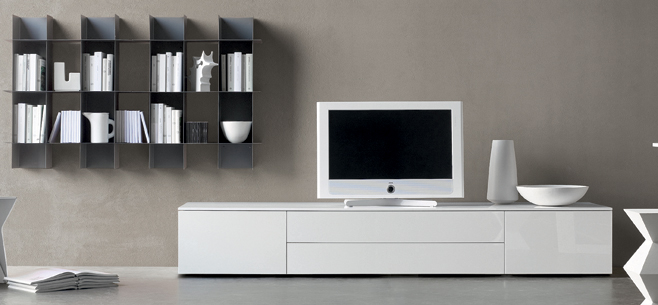
Over the course of the years we have sold many TV units, and with that we have found at that there is more than meets the eye when purchasing the right unit that meets all of your needs. Usually people will want a stylish TV table, and that is their number one priority initially. However there are so many other considerations other than looks, so we thought we’d put together the common questions that should be considered before choosing a TV unit.
What is the size of your largest piece of a/v equipment?
This is very important, as there is no point investing on a brand new beautiful TV unit, only to find that your very expensive audio equipment will not fit inside. When measuring your largest piece you need to size up the height, width and the depth. When measuring the depth also make sure that you include extra clearance space for the cables that come out from the back of the unit. Once you know the full dimensions of the largest pieces of a/v equipment you will then be able to order the correct sized TV table.
What will you be storing inside?
Another important factor. If you have a vast collection of a/v equipment you might want more drop-down doors or even open shelf units to accommodate these so that you will be able to use your remote control to operate the equipment. Or if you only have a single sky box you might wish to place this on the top of your TV unit and just have a run of doors and drawers for storing miscellaneous household items.
What is the minimum/maximum length that you would like the TV unit to be?
This seems quite obvious, but sometimes this step can become an afterthought. Before you even start to search for a TV unit it is always best to know the minimum and maximum lengths in order to find the right size TV unit for your space, and also will help to narrow down your options.
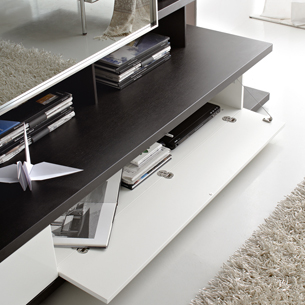 How do you want to access your a/v equipment?
How do you want to access your a/v equipment?
If you need to access you’re a/v equipment by remote control then it is advisable to choose a drop-down door opening or an open shelf – it is also not advisable to put any a/v equipment inside of drawers as the wires will not be able to feed through the back of the unit (due to the drawer carcass). If, however, you have a video sender or magic eye device you will have more flexibility with your door options.
Do you want it floor standing or wall mounting?
This is more of an aesthetic choice, but an important one nonetheless. If choosing a wall mounted TV unit it is important to check the stability of the wall, and the weight of the a/v equipment to be placed inside. As a rule of thumb it is advisable only to mount TV units onto brick walls.
Do you have young children?
You may wonder why is this relevant, but it is important when selecting various options. For example, we would not recommend choosing a wall mounted TV unit as young toddlers have been known to climb onto these which might cause damage to the wall fixings, and in extreme circumstances may cause injury if the unit were to fall. Also we would recommend not going for darker high gloss colours (such as black, dark brown etc) as these tend to show up fingerprints a lot more, so are slightly higher maintenance when there are little fingers around.
Do you need cable management?
When you choose your TV unit you need to plan ahead for which sections will store your a/v equipment – this then allows you to add in cable holes in the back of those areas to feed through wires and cables.
There are many other considerations, such as colour, design, budget or finish, however the above points are the most common questions that it helps to know the answers for before beginning your search. Hopefully the above answers will make the task of finding the right TV unit a little simpler.
To view our selection of Italian tv tables click here.
How to care for high gloss furniture
17 Comments5 November 2012 | Helen

We have quite a lot of high gloss furniture in our showroom which needs to be cleaned daily in order to keep our showroom looking spick and span. Over the years of cleaning our lacquered furniture we have come up , by trial and error, with the quickest and most effective way of caring for high gloss furniture – by the way these instructions apply not just to glossy finishes but also to matt lacquered finishes also.
Less is More
When caring for lacquered furniture it is very important to never use any chemicals or furniture sprays, such as glass cleaners or furniture polish. Glass cleaners are too corrosive and will cause the lacquer to deform, and silicone based cleaners will leave a greasy film over the surface of the lacquer that is almost impossible to remove. A lacquer surface is a painted surface, so when it comes to lacquered furniture less really is more.
What Cleaning Supplies You Will Need
In our cleaning kit in the showroom we have the following items: a feather duster, a pack of soft microfibre cloths, a spray bottle filled with pure clean water and a ‘glass & polishing’ e-cloth.
For day-to-day cleaning we merrily wipe away all our lacquered furniture with a feather duster – this does the trick for removing surface dust that gathers throughout the day. However if we have a particularly busy (read: messy) day and happen to get a lot of fingerprints on our furniture we whip out our miracle cleaning device, otherwise known as an e-cloth. This little lifesaver obliterates greasy fingerprints with ease, you just need to buff away the finger prints (absolutely no cleaning chemicals needed – you can use the e-cloth on it’s own or you can spray a little clean water) and this leaves our furniture looking as good as new again.
How to Tackle Food or Drink Spills
If we happen to spill a drink onto one of our high gloss sideboards we make sure that we wipe it off straight away, so that is does not have time to dry onto the surface. For this we will use a soft, absorbent and dry microfiber cloth – this should do the trick in most cases, but if the spill is particularly stubborn or sticky we will spray the area with a bit of water and whip out the e-cloth for a more intense clean.
We can’t stress how important it is to remove spills off your furniture as quickly as possible. This is very important, especially if you have a light coloured piece of furniture and you spill a dark coloured drink (for example, a white gloss sideboard with a red wine spill). In this scenario speed is of the essence, because if you allow that red wine spill to dry onto a white lacquered surface over night the next day you will be very disappointed to find that after you have wiped the spill off there will be a nasty pinkish-red stain on your beautiful piece of furniture – remember, lacquer is a paint so if there is anything that has the potential to dye it (i.e. red wine, coffee, tea, balsamic vinegar) wipe it off straight away!
The Finishing Touches
If , after you have cleaned your furniture, there is a bit of residual water left on your high gloss surface then get a dry, soft microfibre cloth and buff the area until it is dry – this will give your furniture a lovely high shine. Do not leave water to air dry on your lacquered furniture as this will just leave unattractive water streaks. If you do happen to have any streaky lines left by water simply buff away with the e-cloth and these should come out easily.
In a Nutshell
1. For day to day cleaning a simple wipe down with a feather duster or soft microfibre cloth.
2. Wipe away fingerprints and marks with an e-cloth (or soft microfibre cloth)
3. For a deeper clean spray your high gloss surface with water and clean with an e-cloth - then buff dry with a soft, dry cloth.
4. Wipe up liquid spills immediately, and for more sticky spills use clean water and wipe with an e-cloth.
5. Don’t leave water to air dry – instead buff dry with a dry microfibre cloth
6. Do not use any chemical based cleaners. Pure water used together with an e-cloth is all that is required for more deeper cleaning.
Colour Block: Decorating with Yellow
5 November 2012 | Helen
Yellow is quite iconic, when you think about it. Flag a cab in New York and be greeted by a canary yellow taxi-cab. Watch autumn leaves turn that ever familiar dusky-lemon tone. And the Wizard of Oz wouldn't be the same without the famous yellow brick road. In fact yellow is so ubiquitous that even the Beatles and Coldplay have written songs about it (We All Live in a Yellow Submarine and Yellow, respectively).
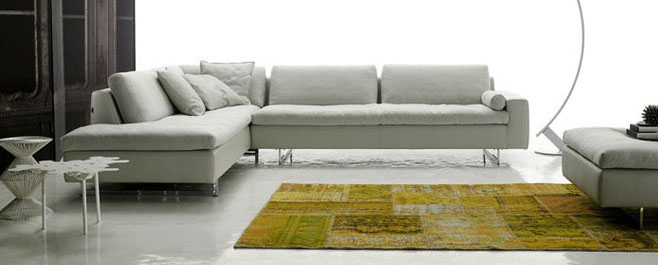
What colours work best with Yellow?
Decorating with yellow can be a challenge - but it is a challenge definitely worth taking when the end results can be so glamorous, fresh and modern. When working with yellow you have to make sure that it becomes the star of the show. Your best bet is mixing yellow with soft, dusky neutral tones, such as whites, beiges, mushroom, fawn or taupe shades. Yellow also looks sensational with darker brown tones, which adds extra impact.

Home-Office Chic
Yellow in this home-office space immediately transforms the look of this room, changing what would have been a safe (or boring?) design into something with immediate impact and personality. I love what the yellow has done to this room - if those sliding doors were in white then the room would have looked washed out - in grey the room would have looked cold and heartless. This beautiful mustard tone really 'pops' and adds life and soul to a very modern, minimal space. Keeping the walls and floor bright white really allows the yellow to sing, and gives a fresh, clean look. The carefully selected storage boxes and files in black and white are also a nice touch. However this use of yellow is quite dramatic, and is only recommended for those who want to make a bold statement.

Colour Co-ordinating with Yellow
This is perhaps my most favourite use of yellow in an interior design scheme. The mustard yellow armchair looks so fresh and modern, and your eye is immediately drawn to this chair which makes you appreciate its unique form and design more so than if it was upholstered in the usual black, grey or brown. And the simple addition of 2 scatter cushions upholstered in the same yummy shade of yellow really ties together the whole look of this room, for instant Italian-chic. The light grey-taupe tone of the sofa really softens and tones down the drama of the brighter colours, which brings all-important harmony and balance to the room.
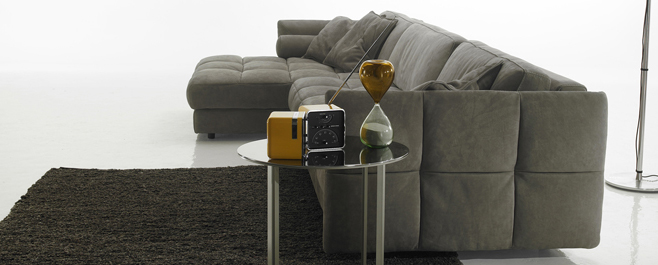
Accessorising with Yellow
If you love yellow but don't want to commit to a large statement piece in such a bold colour choice then it is a lot safer and easier to introduce yellow with some carefully considered accessories. This fawn suede sofa is paired with a deep brown rug, which nicely compliment the white floor and walls. However what really ties together the whole look of this room are the small yellow clock and hour glass - these small, subtle accessories add a zesty punch of mustard yellow, livening up what could have been a quite bland and insipid room.
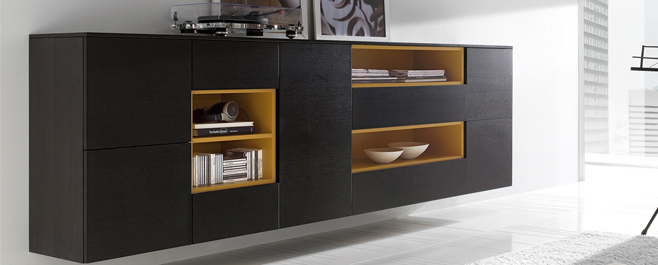
Splashes of Yellow
Another way to subtly bring yellow into your home is to incorporate it within your furniture, but in small flashes of colour rather than large blocks of yellow. This sideboard is mainly a dark oak finish on the exterior area, but exciting splashes of yellow are added to the open sections adding drama, personality and warmth. Again, the neutral tones of the floors and walls really allow the sideboard to take centre stage creating a harmonious, contemporary look.

The harmonious coupling of the mink brown with mustard yellow really is a treat to the eye. This colour combination feels warm, inviting and definitely makes a statement. Again, the yellow offset with white walls and white accessories inside the shelves. I particularly like the bold splash of canary yellow on the adjacent wall - this could have been overkill but somehow it works in the context of this room. Adding a yellow feature wall in your home is also a relatively easy and low risk way of adding yellow into your interior scheme with interesting results to be had.
So to recap, yellow can be stunning so long as it becomes the main point of focus within a colour scheme. If you are choosing to decorate with yellow then compliment it with whites, taupes, and various shades of brown. Don't be afraid to experiment with cushions, rugs, vases, clocks and other ornaments in shades of yellow, and if you're feeling brave choose an eye-catching statement piece (such as an armchair or TV unit) in a beautiful mustard shade to really add an individual and unique look to your interior.
Welcoming Spring with Bright Colours
29 March 2011 | help
2011 promises to be the fashion year of beautiful, bright primary colours. The colours of the Mediterranean will also heavily influence the fashion industry’s designs. This is exciting for the modern furniture industry as in terms of furniture the sleek high gloss pieces in black and white always look stunning when accented with bright primary coloured accessories. Obviously red is the most striking primary colour in our furniture portfolio and the red high-gloss furniture is already becoming extremely popular. People are searching for fun pieces that distinguish their home as a modern, stylish living space – and are using red furniture pieces to express themselves.
For those people 'afraid' of using the primary colours – red, blue and yellow as a main furniture colour theme there are some striking pieces that will help include splashes of colour to a home. Our contemporary furniture portfolio is heavily influenced by the finest contemporary furniture designers and there are some amazing dining chairs, bar stools, chest of drawers and tallboys that can add a dramatic colour accent to a room.
For instance to create a stunning dining room area consider the Italian designed,
Luna dining table in white and team with the striking
Bruno dining chairs in red, blue or green. The bright colour of the dining chairs will create an instant impact that makes a bold style statement.
The Mediterranean colours again are quite easy to introduce into the home – in the kitchen, bar stools in red or green achieve that Mediterranean look; in the bedroom the Mediterranean ambience can be created by using bed linen and scatter cushions in the gorgeous aquas, oranges, golds and greens that all influence the colours of the Med. The
Mellow Fabric Bed also achieves that essential Mediterranean feel to the bedroom – in dark teal or magnificent mulberry the design brings the Med straight into the room. The bedroom is a wonderful room in which to bring a variety of materials – bright and bold colours and sheer fabrics are dominating the material ranges and these help add that accent of bright spring colour.

 How do you want to access your a/v equipment?
How do you want to access your a/v equipment?














